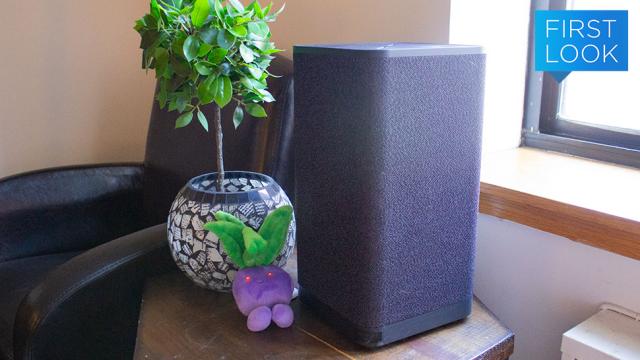I am not a loud party person. At bars or social gatherings, I’m more apt to leave early if the host or venue has music on so high that I have to constantly yell “WHAT?” at my friends. But if that’s your thing, then Ultimate Ears’ latest speaker, the Hyperboom, is the company’s loudest portable Bluetooth speaker yet.
I got to see the Hyperboom at both a private briefing and play around with it in my apartment for a few days. While I didn’t crank the volume up to max at home—I have to think about my jumpy elderly dog and my neighbours’ small children—I did get to hear the Hyperboom at full blast on a random New York City rooftop. The track was a bassy electronica tune, and my Apple Watch Series 5 gave me a warning that I was near something very loud. UE says the Hyperboom’s max volume or “sound pressure level” is 100 dBC. I asked for an equivalent in decibels or watts, but a UE spokesperson told me over email that this was a more accurate measure. Sure!
What I can say is it’s loud enough to fill a large living room, as well as drown out the sound of NYC traffic from a rooftop. Even though the noise at full blast made me cringe, I was impressed the Hyperboom remained completely still and I couldn’t see much vibration on the speaker’s fabric cover either.
According to Ultimate Ears, the Hyperboom is three times as loud and 6.5 times as bassy of its Megaboom 3 speaker. It’s also the biggest UE speaker, measuring 14.3 by 7.5 by 7.6 inches and weighing 13 pounds. I put the Hyperboom side-by-side with the Apple HomePod, and the Hyperboom just completely dwarfed it. This makes sense, considering the purpose UE built this thing for, but it does mean you need to think about where you want to put this in your living space. I’m in a cramped Manhattan studio and finding somewhere to stick the Hyperboom where it didn’t stick out was somewhat of a challenge.
So yes, the Hyperboom is a big boy. It’s still technically portable, but not in the same way as say, the Wonderboom 2. I lugged it up a flight of stairs during my briefing and then later on the New York City subway from the Gizmodo office to my home—the former was fine, the latter I wouldn’t exactly recommend. In a real-life scenario, it’s definitely too big to stuff into a backpack, but the average person shouldn’t have trouble transporting it from the living room to the yard. It also helps that there’s a handy, adjustable strap on the back to help with hauling the thing around.
As for the rest of the Hyperboom’s specs, it has two 4.5-inch woofers, two 1-inch tweeters, and two 3.5-inch passive radiators. In addition to Bluetooth, it also supports one 3.5mm auxiliary cable and has one optical audio port. It’s also got an IPX4 rating, so while it probably won’t survive getting dropped into a pool, splashes and drink spills should be fine. It’s also got an estimated 24 hours of battery life, and UE told me that you should be able to get three continuous hours of play at max volume. (But, for the sake of your ears, maybe don’t do that.)
I played a few albums on the Hyperboom, and the sound was pretty crisp—though as you might expect, with an added emphasis on the bass. That said, it didn’t noticably distort music when I had a few indie tracks on in the background while doing chores or milling about. You can always futz around with equaliser in the companion app as well if that sort of thing bothers you.
Feature-wise, the Hyperboom is similar to other UE speakers. Like the Boom 3, the Hyperboom has the Magic Button on top of the speaker to let you navigate through tracks as well as preload certain playlists from services like Apple Music, Amazon Music, or Deezer Premium—Spotify is for Android only, however. It also links up with other compatible UE speakers and works with the Ultimate Ears Boom app. Another touch is that the Hyperboom now has physical buttons that let you switch between two connected Bluetooth devices. So, say you and your roommate are both connected to the Hyperboom, you can easily switch between users or see who is connected at a given time.
As for style, the Hyperboom is pretty nondescript. At launch, it’ll only come in the black colour—somewhat a departure from UE’s other offerings, which come in many different colours. UE told me that the reasoning is that unlike its other speakers, the Hyperboom is intended to be more stationary, and therefore needs to better blend with a wide range of home decor.
The Hyperboom is priced at $599, which is significantly more expensive than UE’s other speakers—though to be fair, it’s competitively priced for a larger speaker meant for thumping bass lines and parties. UE says it expects the Hyperboom to ship in early March.
